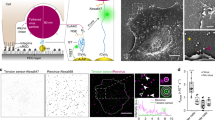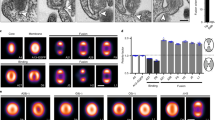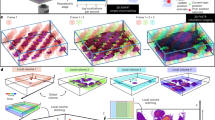Abstract
The spread of retroviruses between cells is estimated to be 2–3 orders of magnitude more efficient when cells can physically interact with each other1,2. The underlying mechanism is largely unknown, but transfer is believed to occur through large-surface interfaces, called virological or infectious synapses3,4,5,6. Here, we report the direct visualization of cell-to-cell transmission of retroviruses in living cells. Our results reveal a mechanism of virus transport from infected to non-infected cells, involving thin filopodial bridges. These filopodia originate from non-infected cells and interact, through their tips, with infected cells. A strong association of the viral envelope glycoprotein (Env) in an infected cell with the receptor molecules in a target cell generates a stable bridge. Viruses then move along the outer surface of the filopodial bridge toward the target cell. Our data suggest that retroviruses spread by exploiting an inherent ability of filopodia to transport ligands from cell to cell.
This is a preview of subscription content, access via your institution
Access options
Subscribe to this journal
Receive 12 print issues and online access
$209.00 per year
only $17.42 per issue
Buy this article
- Purchase on Springer Link
- Instant access to full article PDF
Prices may be subject to local taxes which are calculated during checkout





Similar content being viewed by others
References
Dimitrov, D. S. et al. Quantitation of human immunodeficiency virus type 1 infection kinetics. J. Virol. 67, 2182–2190 (1993).
Carr, J. M., Hocking, H., Li, P. & Burrell, C. J. Rapid and efficient cell-to-cell transmission of human immunodeficiency virus infection from monocyte-derived macrophages to peripheral blood lymphocytes. Virology 265, 319–329 (1999).
Igakura, T. et al. Spread of HTLV-I between lymphocytes by virus-induced polarization of the cytoskeleton. Science 299, 1713–1716 (2003).
McDonald, D. et al. Recruitment of HIV and its receptors to dendritic cell-T cell junctions. Science 300, 1295–1297 (2003).
Jolly, C., Kashefi, K., Hollinshead, M. & Sattentau, Q. J. HIV-1 cell to cell transfer across an Env-induced, actin-dependent synapse. J. Exp. Med. 199, 283–293 (2004).
Alfsen, A., Yu, H., Magerus-Chatinet, A., Schmitt, A. & Bomsel, M. HIV-1-infected blood mononuclear cells form an integrin- and agrin-dependent viral synapse to induce efficient HIV-1 transcytosis across epithelial cell monolayer. Mol. Biol. Cell 16, 4267–4279 (2005).
Sherer, N. M. et al. Visualization of retroviral replication in living cells reveals budding into multivesicular bodies. Traffic 4, 785–801 (2003).
Lehmann, M. J., Sherer, N. M., Marks, C. B., Pypaert, M. & Mothes, W. Actin- and myosin-driven movement of viruses along filopodia precedes their entry into cells. J. Cell Biol. 170, 317–325 (2005).
Ramirez-Weber, F. A. & Kornberg, T. B. Cytonemes: cellular processes that project to the principal signaling center in Drosophila imaginal discs. Cell 97, 599–607 (1999).
De Joussineau, C. et al. Delta-promoted filopodia mediate long-range lateral inhibition in Drosophila. Nature 426, 555–559 (2003).
Hsiung, F., Ramirez-Weber, F. A., Iwaki, D. D. & Kornberg, T. B. Dependence of Drosophila wing imaginal disc cytonemes on Decapentaplegic. Nature 437, 560–563 (2005).
Davey, R. A., Zuo, Y. & Cunningham, J. M. Identification of a receptor-binding pocket on the envelope protein of friend murine leukemia virus. J. Virol. 73, 3758–3763 (1999).
Zavorotinskaya, T., Qian, Z., Franks, J. & Albritton, L. M. A point mutation in the binding subunit of a retroviral envelope protein arrests virus entry at hemifusion. J. Virol. 78, 473–481 (2004).
Ponti, A., Machacek, M., Gupton, S. L., Waterman-Storer, C. M. & Danuser, G. Two distinct actin networks drive the protrusion of migrating cells. Science 305, 1782–1786 (2004).
Chen, C., Weisz, O. A., Stolz, D. B., Watkins, S. C. & Montelaro, R. C. Differential effects of actin cytoskeleton dynamics on equine infectious anemia virus particle production. J. Virol. 78, 882–891 (2004).
Mothes, W., Boerger, A. L., Narayan, S., Cunningham, J. M. & Young, J. A. Retroviral entry mediated by receptor priming and low pH triggering of an envelope glycoprotein. Cell 103, 679–689 (2000).
Bates, P., Young, J. A. & Varmus, H. E. A receptor for subgroup A Rous sarcoma virus is related to the low density lipoprotein receptor. Cell 74, 1043–1051 (1993).
Watkins, S. C. & Salter, R. D. Functional connectivity between immune cells mediated by tunneling nanotubules. Immunity 23, 309–318 (2005).
Gupta, N. & DeFranco, A. L. Visualizing lipid raft dynamics and early signaling events during antigen receptor-mediated B-lymphocyte activation. Mol. Biol. Cell 14, 432–444 (2003).
Onfelt, B. et al. Structurally distinct membrane nanotubes between human macrophages support long-distance vesicular traffic or surfing of bacteria. J. Immunol. 177, 8476–8483 (2006).
Ziv, N. E. & Smith, S. J. Evidence for a role of dendritic filopodia in synaptogenesis and spine formation. Neuron 17, 91–102 (1996).
Niell, C. M., Meyer, M. P. & Smith, S. J. In vivo imaging of synapse formation on a growing dendritic arbor. Nature Neurosci. 7, 254–260 (2004).
Melikyan, G. B., Barnard, R. J., Abrahamyan, L. G., Mothes, W. & Young, J. A. Imaging individual retroviral fusion events: from hemifusion to pore formation and growth. Proc. Natl Acad. Sci. USA 102, 8728–8733 (2005).
Ochoa, G. C. et al. A functional link between dynamin and the actin cytoskeleton at podosomes. J. Cell Biol. 150, 377–389 (2000).
Pelkmans, L., Kartenbeck, J. & Helenius, A. Caveolar endocytosis of simian virus 40 reveals a new two-step vesicular-transport pathway to the ER. Nature Cell Biol. 3, 473–483 (2001).
Klement, V., Rowe, W. P., Hartley, J. W. & Pugh, W. E. Mixed culture cytopathogenicity: a new test for growth of murine leukemia viruses in tissue culture. Proc. Natl Acad. Sci. USA 63, 753–758 (1969).
Acknowledgements
We are grateful to T. Rapoport for his support. We thank Z. Jiang for assistance with scanning electron microscopy, and P. Uchil and J. Jin for critical reading of the manuscript. This work was supported by National Institutes of Health (NIH) grants R01CA098727 and R21 AI065284, as well as the Searle Scholars Program to W.M., and a Leopoldina Fellowship BMBF-LPD 9901/8-75 to M.L.
Author information
Authors and Affiliations
Contributions
N.M.S, with support from M.J.L, L.F.J.-S. and W.M. were responsible for the experimental work. C.H. and M.P. performed transmission electron microscopy. W.M. and N.M.S. were involved in project planning, data analysis and writing.
Corresponding author
Ethics declarations
Competing interests
The authors declare no competing financial interests.
Supplementary information
Supplementary Information
Supplementary Figures S1, S2 (PDF 384 kb)
Supplementary Information
Supplementary Movie S1 (MOV 7127 kb)
Supplementary Information
Supplementary Movie S2 (MOV 4004 kb)
Supplementary Information
Supplementary Movie S3 (MOV 1442 kb)
Supplementary Information
Supplementary Movie S4 (MOV 1518 kb)
Supplementary Information
Supplementary Movie S5 (MOV 2785 kb)
Supplementary Information
Supplementary Movie S6 (MOV 625 kb)
Supplementary Information
Supplementary Movie S7 (MOV 3925 kb)
Supplementary Information
Supplementary Movie S8 (MOV 2906 kb)
Rights and permissions
About this article
Cite this article
Sherer, N., Lehmann, M., Jimenez-Soto, L. et al. Retroviruses can establish filopodial bridges for efficient cell-to-cell transmission. Nat Cell Biol 9, 310–315 (2007). https://doi.org/10.1038/ncb1544
Received:
Accepted:
Published:
Issue Date:
DOI: https://doi.org/10.1038/ncb1544
This article is cited by
-
Chikungunya virus cell-to-cell transmission is mediated by intercellular extensions in vitro and in vivo
Nature Microbiology (2023)
-
Capturing the start point of the virus–cell interaction with high-speed 3D single-virus tracking
Nature Methods (2022)
-
Viral and host heterogeneity and their effects on the viral life cycle
Nature Reviews Microbiology (2021)
-
Highly efficient intercellular spreading of protein misfolding mediated by viral ligand-receptor interactions
Nature Communications (2021)
-
Super-resolution imaging of the dynamic cleavage of intercellular tunneling nanotubes
Frontiers of Optoelectronics (2020)



